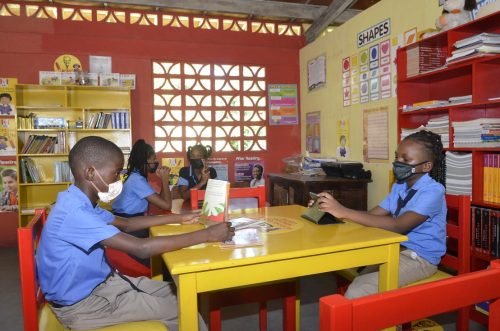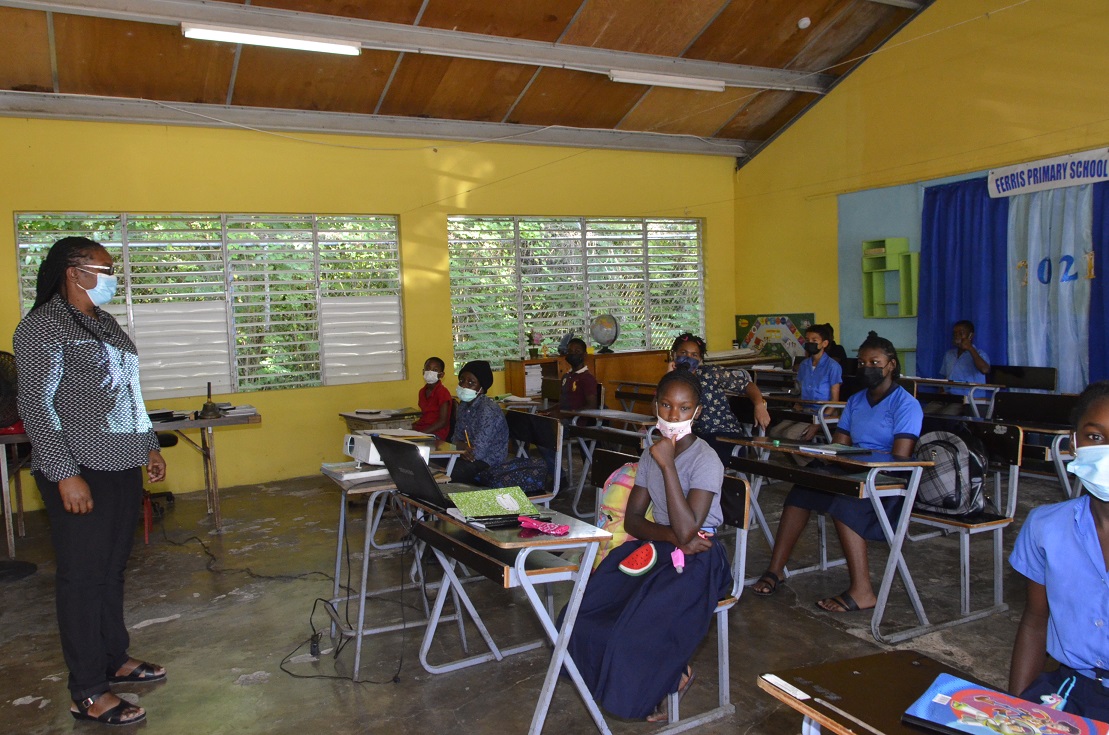Ferris Primary Implements Literacy and Numeracy Programmes to Address Learning Loss
By: , November 29, 2021The Key Point:
The Facts
- “The students are coached daily on the COVID-19 protocols, so they know what to do once they get on the school compound. We have janitors and twice per day the classes are sanitized,” Mrs. James shares.
- “I feel excited and nervous at the same time, but I really like face to face school because… I get to learn more than when I am online and if I have a question I can go straight to my teacher, instead of having to speak up online which I don’t really like,” she said.
The Full Story
The administration at Ferris Primary School in Westmoreland, is implementing strategic literacy and numeracy programmes to address learning loss stemming from the closure of schools due to the COVID-19 pandemic.
The institution is one of 376 schools across the island that reopened for face-to-face classes on November 8, following approval by the Ministry of Education, Youth and Information.
Speaking in an interview with JIS News, the school’s Acting Principal, Karen James, says a vast majority of students have missed out considerably on learning caused by challenges with online school.
She states that students lost progress in mathematics and reading but special programmes are being devised to ensure every child can fulfil their potential.
“Writing skills have also diminished because when they were online, they were mostly using their tablets and their laptops, so penmanship has dropped. Also reading, as many of them were not logging on at all and even though we had them download the app from the Ministry of Education, Youth, and Information site for their reading books, some of them still would not log on to it to get the books to read,” Mrs James said.
“Math is picking up a little bit, but generally on the whole, many of the students have fallen back. But we have plans in place for a comprehensive reading programme to target all grades. We have a math resource room, which I plan to refurbish in the coming months because our focus this year is on Language Arts and Mathematics,” she continued.
The acting principal is expressing confidence that the strategies will positively impact the academic performance of students.
Meanwhile, Mrs. James says operations have been running smoothly since the resumption of face-to-face learning.
She notes that grades four, five and six have seamlessly transitioned to full face to face classes, while grades one, two and three are being engaged both online and in-person.
Mrs. James notes that attendance for the upper grades has been steadily improving, adding that she is optimistic that the numbers will increase over the coming weeks.
“I was expecting a bit of a greater turnout because when we had our Parent Teachers Association (PTA) meeting on November 3, all the parents were excited about sending their children back to school. But I remain optimistic. Now our average attendance daily is about 28 (for upper school) and so that’s not bad because not all the grades are out yet… but I’m expecting more in the coming weeks,” the Acting Principal notes.
She indicates that the prescribed health and safety protocols are being strictly enforced, noting that rules regarding mask wearing, social distancing and proper washing of hands are reinforced daily.

“The students are coached daily on the COVID-19 protocols, so they know what to do once they get on the school compound. We have janitors and twice per day the classes are sanitized,” Mrs. James shares.
“Students know that they are supposed to be wearing their masks when they come through the gate, their hands are washed and sanitized, temperatures are checked, and they proceed to their classroom. No sharing is done as all students have their own textbooks and we provide writing books, rulers, and pencils for those who don’t have, so there is no sharing. So, we try our best to minimize contact at all times,” she adds.

For his part, grade six teacher, Owen Porter, says he is enthusiastic to be back in the physical classroom setting after over a year of virtual learning.

“For me, face to face couldn’t have come any sooner… because I was not getting my students online. On average, the most I would get online is five, now I am getting 16 so I am relieved, overjoyed to be back at school. The students are also excited to be here, and they have also expressed to me that they were not understanding the concepts well online but since they have returned to school, they are getting instructions clearer and learning,” he shares.
Mr. Porter continues to integrate the use of technology in the teaching and learning process, as well as utilize strategies to address learning loss.
“I realize that the students are deficient in the basic skills to learn new concepts so I integrated the teaching of basic skills with the curriculum I am doing now and what we do is use a lot of technology to supplement the learning, so that we can move at a faster pace while reinforcing the concepts,” Mr. Porter says.
Grade four student, Tevoy Campbell, tells JIS News that he is happy to be able to interact personally with his teacher.
“It feels good as I can talk to my teacher [and] I can ask her to explain things to me. When I raise my hands on the online school [platform] she may not see it so when I raise my hand in the classroom, she can see it and explain it to me,” he tells JIS News.
For grade six student, Carradine Porter, returning to the physical classroom prompted feelings of nervousness and excitement.
“I feel excited and nervous at the same time, but I really like face to face school because… I get to learn more than when I am online and if I have a question I can go straight to my teacher, instead of having to speak up online which I don’t really like,” she said.


